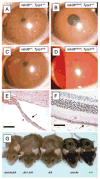Analysis of ocular hypopigmentation in Rab38cht/cht mice
- PMID: 17724166
- PMCID: PMC1989767
- DOI: 10.1167/iovs.06-1464
Analysis of ocular hypopigmentation in Rab38cht/cht mice
Abstract
Purpose: To characterize the ocular phenotype resulting from mutation of Rab38, a candidate gene for Hermansky-Pudlak syndrome.
Methods: Chocolate mice (cht, Rab38(cht/cht)) and control heterozygous (Rab38(cht/)(+)) and wild-type mice were examined clinically, histologically, ultrastructurally, and electrophysiologically. Mice homozygous for both the Rab38(cht) and the Tyrp1(b) alleles were similarly examined.
Results: Rab38(cht/cht) mice showed variable peripheral iris transillumination defects at 2 months of age. Patches of RPE hypopigmentation were noted clinically in 57% of Rab38(cht/cht) eyes and 6% of Rab38(cht/)(+) eyes. Rab38(cht/cht) mice exhibited thinning of the iris and RPE and larger b-wave amplitudes in the scotopic range when compared with the control animals. Compared with wild-type mice, Rab38(cht/cht) melanosomes were smaller and there were fewer in neuroectodermally derived retinal pigment epithelium; in neural crest-derived choroid melanocytes, they were smaller in size only. Mutation of both Rab38 and Tyrp1 produced mice with ocular and coat color pigment dilution greater than that seen with either mutation alone. Comprehensive clinical and pathologic analyses showed no other organ system or blood defects in Rab38(cht/cht) mice.
Conclusions: Rab38(cht/cht) mice show ocular characteristics reminiscent of human oculocutaneous albinism, as well as iris and RPE thinning. The synergistic effects of the Rab38(cht) and Tyrp1(b) alleles suggest that TYRP1 is not the only target of RAB38 trafficking. This mouse line provides a useful model for studying melanosome biology and its role in human ocular diseases.
Figures









References
-
- Bennett DC, Lamoreux ML. The color loci of mice: a genetic century. Pigment Cell Res. 2003;16:333–344. - PubMed
-
- Chang B, Smith RS, Hawes NL, et al. Interacting loci cause severe iris atrophy and glaucoma in DBA/2J mice. Nat Genet. 1999;21:405–409. - PubMed
-
- Anderson MG, Smith RS, Hawes NL, et al. Mutations in genes encoding melanosomal proteins cause pigmentary glaucoma in DBA/2J mice. Nat Genet. 2002;30:81–85. - PubMed
-
- Brilliant MH. The mouse p (pink-eyed dilution) and human P genes, oculocutaneous albinism type 2 (OCA2), and melanosomal pH. Pigment Cell Res. 2001;14:86–93. - PubMed
Publication types
MeSH terms
Substances
Grants and funding
LinkOut - more resources
Full Text Sources
Other Literature Sources
Medical
Molecular Biology Databases

